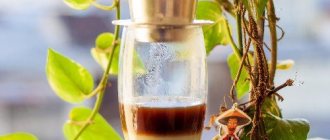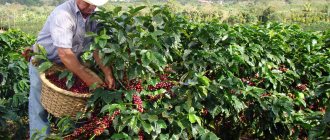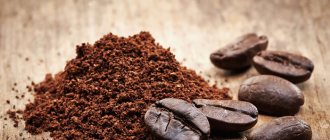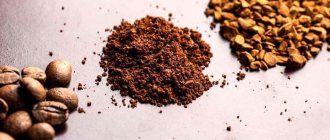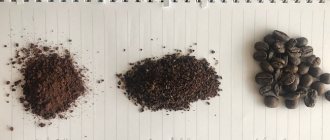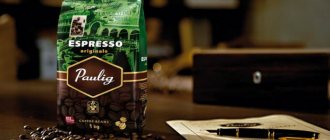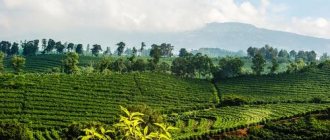Taste
At first glance, Arabica and Robusta are quite close relatives, they even belong to the same Madder family.
The main difference between Arabica and Robusta is taste. The first type is considered softer, slightly sour. Arabica can have several shades, depending on the variety:
- fruit;
- astringent, as if with spices;
- floral;
- walnut;
- chocolate;
- berry.
Robusta will appeal to connoisseurs of strong and tart coffee. After roasting, the taste becomes slightly less bitter. A characteristic feature of this type is considered to be stable volumetric foam. Robusta is suitable for espresso lovers.
Chemical composition of grains
Arabica beans produce a drink that is less strong, with a rich taste and aroma.
Robusta produces a sharp, bitter, but very invigorating infusion with a faint odor. Arabica beans contain a large amount of essential oils. The percentage of their content reaches 18%. And there is only 1.5% caffeine. After roasting, the grains are valuable for vitamin PP. Arabica also contains lipids, proteins and sugars.
Robusta is translated as “strong”, since the concentration of caffeine in it is 2 times higher than in Arabica - 3%. And there are only 8% essential oils, which explains the lack of a strong smell and taste. Roasting the beans before preparing the drink softens the bitterness slightly. A high concentration of caffeine gives a good invigorating effect, and the tart taste stimulates the receptors. As a result, a person feels less tired, so this drink is usually consumed in the morning.
Popular varieties
Arabica requires cross-pollination, hence the rapidity of infection and mutation.
Arabica may be mistakenly called a coffee variety. But in fact it is a type of plant. And the most popular varieties of coffee made from it include:
- Bourbon;
- Shinzan;
- Maragogyp;
- Typica;
- Bali;
- Katura;
- Aramosa.
Each variety has a characteristic taste and aroma. Arabica is very common and is considered a classic coffee, which is why there are so many varieties. There are significantly fewer varieties of Robusta:
- Conillon du Brazil (characteristic earthy flavor);
- Ambry (classic variety);
- Quilu (more often used in mixtures than solo).
Each variety was grown for its own purpose. Some reveal the taste of the drink better, while others grow and ripen faster. There are more varieties of Arabica, but Robusta also has plenty to choose from.
When is it open?
Whether it is South America or Africa, Arabica from these places turns out to be unique, with a taste palette inherent only to a specific region.
The homeland of robusta is Africa, first discovered in the floodplain of the Congo River. Arabica has been known to people since the 14th century. Since then, a large number of varieties and methods of roasting beans have appeared. But the classic taste of coffee has not changed since then.
Robusta was classified as a separate species only at the end of the 19th century. Before this, it was not drunk separately, but only mixed with others, so there was no need for identification. But now this type is highly valued by true lovers of strong coffee.
Where does it grow
Farmers believe that the future lies in combining the qualities of Arabica and Robusta in new varieties.
Mountain areas are better suited for cultivating Arabica. The optimal altitude above sea level for this plant is 600-2000 m. Arabica does not like heat; the optimal temperature for growth and ripening is from 15 to 24°C. Precipitation should be from 1200 to 2000 mm per year. If there are more of them, the tree may begin to rot.
Robusta trees prefer foothills and flat terrain. Robusta does not like heights too much; it is grown on land up to 800 m above the sea. But this plant requires heat and moisture. The tree grows best at temperatures from 16 to 36°C, and requires a rainfall of 2000 to 3000 mm. If climatic conditions do not meet the norm, the plant will dry out and die.
What is Arabica
There are plantations where coffee beans are grown in Brazil, America, Mexico, Nicaragua, Vietnam and other countries of the world.
Highland Arabica is without a doubt the most popular type of bean.
According to historical data, it was discovered in the 14th century in the Caffa region (Ethiopia). Today, tall coffee trees sprout there.
Brazil is the main supplier of such a product in the modern world. The variety differs from its main competitor, Robusta, primarily in its compactness. The average length of such a tree is 2 meters.
The plants grown to harvest such grains are very beautiful. They have attractive gray bark, light green foliage and large, snow-white flowers that exude a wonderful scent.
Despite their visual appeal, Arabica trees are very difficult to care for. They react painfully to weather changes and are afraid of direct sunlight and heat. For this reason, many countries with unstable weather and hot climates have abandoned the cultivation of such trees.
An important condition for the ripening of this coffee is its location above sea level at least 800 meters. The plant will not bear fruit if planted in the cold season, when the air temperature is below 15 degrees Celsius.
And the variety often gets sick. Arabica trees are regularly attacked by parasites. To maintain them in proper condition, preventive maintenance must be carried out regularly.
Appearance of grains
Collected and cleaned, Arabica and Robusta beans have pronounced external differences.
Arabica and Robusta beans differ significantly in appearance. In the first species they reach up to 8 mm and have an oval shape. After roasting, the beans have an even brown color.
The shape of the Robusta grain is closer to a circle. They are smaller in size than Arabica beans. After roasting, the color of the beans does not become uniform; they can have several shades of brown.
Plant size
Today's breeding experiments are more aimed at increasing productivity and reducing the risks of growing coffee, so many newly bred Arabica varieties, although they bring more yield, are inferior in taste to their predecessors.
Since Arabica grows in high mountain areas, it has a small trunk height. The maximum size of a tree is 5 m. In conditions of low rainfall and low temperatures, growing higher is simply irrational; the plant will not have enough nutrients.
Robusta grows in flat areas, so the tree can reach 10-12 m. Climatic conditions with high rainfall do not limit the plant in nutrients and water. And the distance from the sun's rays provokes the tree to grow in height. Therefore, Robusta is almost 2 times higher than Arabica.
Robusta: distinctive features
Robusta is characterized by a harsher and bitter taste and a less intense aroma. That is why most often this type of coffee is found in a mix with more delicate and sweet Arabica beans. According to many experts, Robusta with impurities is ideal for making strong espresso with aromatic crema.
As for the plant itself, it is not as picky as the Arabica tree. For normal life, it does not need special climatic conditions and even grows in hot Africa and Asia, where there is drought or, conversely, high humidity from time to time. Also, the coffee bush on which Robusta beans grow bears fruit more actively and reproduces more easily, thereby bringing greater profit to its owner. In one year, such a coffee bush produces two and sometimes three times more beans than an Arabica tree.
whimsicality
Robusta's stability is largely due to self-pollination, hence its good resistance to external influences.
Growing Arabica is more difficult due to climatic restrictions. It can also be affected by parasites and diseases. This is due to the low concentration of caffeine, which can prevent infection.
Caring for a robusta tree is easier. It is suitable for a wider range of climatic conditions, and is also not afraid of parasites and diseases. Due to caffeine, which is 2 times more than in Arabica, pathogens do not affect Robusta beans. The yield of this species is also higher, as conditions with high rainfall suit it, which stimulates the growth and ripening of fruits.
Basic historical facts
- Place of discovery: The first mentions of Arabica were in Ethiopia, and Robusta in Uganda.
- Places of growth: Arabica is cultivated in America, Africa, Asia, the Caribbean and Oceania. Robusta is mainly cultivated on an industrial scale in Asia and Africa.
- Leader in production: Leader in Arabica production - Brazil, Robusta - Vietnam.
- Share in world production: 70% of the world volume belongs to Arabica, 30% to Robusta.
- Characteristics of the coffee tree
- Tree height: Arabica can grow up to 10 meters, robusta up to 15 meters.
- Growing altitude: Arabica grows from 900 to 2500 meters above sea level, robusta grows lower, from 200 to 900 meters.
- Resistance to parasites and diseases: Arabica is less resistant to diseases, robusta, on the contrary, has high resistance to parasites and diseases.
Usage
Robusta has a much higher content of tannins, which are responsible for bitterness, than Arabica.
Arabica and Robusta differ in purpose.
The first type is used in its pure form; an aromatic, weak drink is prepared from it. And the second is suitable for espresso, as it has a powerful invigorating effect. It is also added to mixtures for making coffee, and is also used as a base for creating instant drinks. Robusta is drunk in its pure form only by true connoisseurs who like its bitterness and tart taste.
Strong, resilient, unpretentious
Robusta or Congolese coffee (Coffea canephora) is one of the most common types of coffee tree. The name is translated into Russian as “strong” and “hardy”, and for good reason: Robusta easily rises where delicate Arabica can dry out or freeze; it is not affected by coffee diseases and is avoided by insect pests. But robusta beans contain less aromatic substances and oils, which makes it less aromatic and rich in flavor.
Congolese coffee is now grown in Brazil, Angola, Congo, Uganda, Cameroon and Asian countries, especially Vietnam, which supplies most of the world's robusta.
We have collected the most interesting opinions of tea.ru experts and tell you in what cases an unpretentious hooligan robusta with its bitter taste and nutty notes can be a better choice than its gentle “Arabian sister”.
If your work requires you to regularly wake up early in the morning, get yourself a separate jar of robusta beans and brew your first morning coffee from it. The thing is that the caffeine content in Arabica is from 0.65 to 2.7%, and in Robusta it is about 2 times more. Robusta quickly and powerfully invigorates, tones the body and relieves the feeling of fatigue.
Natural Arabica almost always has a slight (sometimes large) acidity. This is a distinctive feature of the species: the coffee berry of Arabian coffee is not similar to a cherry and is distinguished by a sweet and sour taste, which is transmitted to the beans.
Robusta may or may not be bitter, but it almost never has any sourness.
Grain differs from grain. Wild robusta, found in the foothills of the Congo, has long been changed by breeders almost beyond recognition. Preserving the natural hardiness of the plant, they developed many varieties that are distinguished by a soft and bright taste, not inferior in characteristics to Arabica. Here are some of them:
- Conillon du Brasil is a Brazilian robusta variety with an earthy aroma and a thick, rich flavor. Plays well “paired” with Brazilian Arabica.
- Java Ineak is an Indonesian robusta grown in Java.
- Ambry is an Angolan robusta that can be used as a single variety and brewed in alternative ways.
- Quilu is a rare variety of Congolese robusta that perfectly complements Arabica and gives a strong taste and brightness to the drink.
- Indian Peaberry is a grain with a balanced and mild taste and rich aroma.
- And of course, Vietnamese robusta from the mountainous province of Dalat is widely known, with its aroma of fried bread, spices and dark chocolate.
In any case, experts agree that plantation Robusta, which has been cared for with love, is much better than Arabica, which has not spent a lot of time and effort caring for. The final result is also influenced by terroir, weather conditions, harvesting and processing methods, and, of course, the degree of roasting and cooking method. Robusta, by the way, is not particularly suitable as an alternative - it is mostly beans for a coffee machine.
Important! The taste of mold, damp earth or hay is not a characteristic of robusta, but an indicator that there are grain defects. Good Robusta is neutral in taste.
Classic Italian espresso is always a mixture of different types of coffee. Arabica in this blend is responsible for the rich aroma and richness of taste, and robusta is responsible for the tonic effect, density of the drink and stable cream.
Coffee beans Panacea “Uganda Robusta”, 1000 g -25%
510 rub. 679 rub.
Ground coffee Ipnosi “Robusto”, 100 g 225 rub.
Coffee capsules Di Maestri “Robusto”, for Nespresso coffee machine, 10 capsules 326 rub.
Robusta on TEA.RU
When choosing a mixture, be guided by the percentage of each type of coffee it contains:
- The proportion of 90% Arabica to 10% Robusta produces a gentle coffee with an invigorating effect.
- 80% to 20% – thick, dense coffee, in which there is room for both sourness and light characteristic bitterness.
- 70% to 30% is a strong, rich drink without sourness, it tones well and saturates the body with antioxidants.
- 60% to 40% is the best option for those who like “to make it stronger.” Taste with pronounced coffee bitterness, without sweetness or sourness.
If you prefer freeze-dried coffee, chances are you're drinking Robusta with Arabica (and not the other way around). Instant coffee is made from inexpensive robusta, so you shouldn’t expect a wonderful taste from it, but it does an excellent job of “wake up” the function.
Cost of Arabica and Robusta
Arabica is more expensive than robusta due to the greater risks and costs of cultivation.
The price of arabica is usually higher than that of robusta. This is due to the peculiarities of growing the species, as well as its taste characteristics. But there are also expensive, rare varieties of Robusta. Although the average cost of this type is several times lower compared to Arabica. This is explained by the low taste of robusta and the unpretentiousness of the tree to external conditions.
Arabica and Robusta are different types of coffee, each of which includes several varieties. They are completely different in taste, and their climatic and geographical conditions are completely different. Therefore, it is not difficult to make a choice between Arabica and Robusta, you just need to try them.
Famous brands make their products from these two types of coffee: Dallmeier, Lavazza, Carte Noir, Paulig, about which you can learn a lot of interesting and useful information on our website.
Genetic differences
All species of living organisms have their own unique genetic code. For trees of the genus Coffea, this rule is no exception, because their representatives differ in some characteristics and characteristics.
Robusta coffee has 22 chromosomes, Arabica coffee has 44.
This explains the variety of flavor and aromatic qualities of the latter. Each gene forms a specific trait. The more genes, the higher the species variability, the more varieties breeders can develop
